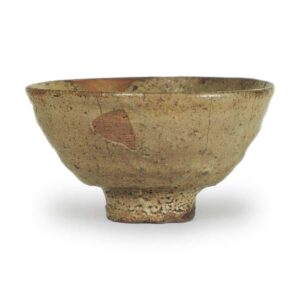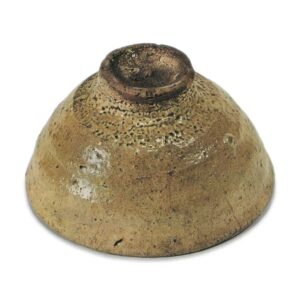

Collection: Fujita Art Museum
Height: 8.0 – 8.7 cm
Diameter: 14.5 – 14.9 cm
Foot diameter: 5.2 cm
Height: 1.8 – 2.0 cm
This is a unique well-shaped tea bowl, with a large size and a shape similar to that of a large well, but with a glaze similar to that of a small well. The outside box has a label saying “Aoi-do”, but we have decided to place it in the large well category, based on its shape and size. Compared to the usual well-shaped tea bowls, this one is somewhat rough in both shape and texture, and this roughness gives the tea bowl a kind of wildness that is a great charm.
There is a large triangular hima on the side, and the rough brown clay is exposed beautifully there. The hima, or unglazed part, is originally a result of a mistake made during the glazing process, but in terms of tea bowl appreciation, it is often prized as a unique feature. In addition, the foot of the bowl is like a bamboo joint, and the glaze inside the foot is very thin, so the rough, dark clay can be seen clearly, especially on the inside. Furthermore, there is a part of the rim where the glaze is also thin, and only this part shows the rough, brown clay. The rough red appearance in the blue-tinged glaze is one of the highlights of this tea bowl.
The shape is the expected Oido shape, but the work on the potter’s wheel is somewhat rough, and it is slightly tilted, so it is not very elegant. Even though it lacks a certain amount of refinement, the rustic appearance is rather friendly, and the rough curves seen in the wheel marks on the side are actually quite attractive. This appearance is not something that can be created through skill, and it is especially deep that it was born from the rough climate of Korea.
The glaze is a dull gray tinged with blue, and it is slightly cloudy, with almost no craquelure. However, in the places where the glaze layer is thickened in a very small part, you can faintly see what looks like craquelure, but overall, it is the same as the glaze tone of Aoido. The glaze on the foot ring is kaeragi, but it is not very colorful, and is very similar to the glaze on the foot ring of Aoido ware. In addition, the glaze contains fine white sand grains, and there are also small black sesame seeds dotted around. In particular, the inside of the bowl is covered in many holes that look like they have been made with a needle, and there are also traces of rubbing, and all of these things fuse together into a single form and color, giving the bowl a wabi-like rustic charm.
There are no signs of repair on the inside or outside. There are three areas of repair on the rim, and there are also seven or eight vertical cracks.
The attached bag is a detour. On the black-lacquered inner box lid, there is the gold-lettered inscription “Asakayama”. The origin of this box inscription is unknown. There is a label on the outer box that reads “Aoidono Asakayama teacup”.
It was passed down from the Kawasaki family in Kaga to the Ibarakiya Inagawa Yasuemon in Osaka, and later entered the Fujita family.



